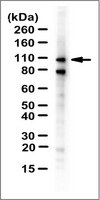Defective NF-κB signaling in metastatic head and neck cancer cells leads to enhanced apoptosis by double-stranded RNA.
Umemura, N; Zhu, J; Mburu, YK; Forero, A; Hsieh, PN; Muthuswamy, R; Kalinski, P; Ferris, RL; Sarkar, SN
Cancer research
72
45-55
2012
Show Abstract
Ligands to several Toll-like receptors (TLR), which mediate innate immune responses and chronic inflammation have been used as adjuvants to immunotherapy to enhance their antitumor activity. In particular, double-stranded RNAs that are cognate ligands of TLR3 have been used to trigger proapoptotic activity in cancer cells. However, a mechanistic understanding of TLR3-mediated apoptosis and its potential involvement in controlling tumor metastasis has been lacking. In this study, we used paired cell lines and fresh tumor specimens, derived from autologous primary and metastatic head and neck squamous cell carcinoma, to investigate the role of TLR3 signaling in metastatic progression. Compared with primary tumor cells, metastatic tumor cells were highly sensitive to TLR3-mediated apoptosis after double-stranded RNA treatment. Enhanced apoptosis in metastatic cells was dependent on double-stranded RNA and TLR3 and also the TLR3 effector signaling protein TRIF. Downstream responses requiring NF-κB were critical for apoptosis in metastatic cells, the defects in which could be resuscitated by alternative pathways of NF-κB activation. By elucidating how TLR3 ligands trigger apoptosis in metastatic cells, our findings suggest insights into how to improve their clinical use. | 22058147
 |
High-throughput screening for TLR3-IFN regulatory factor 3 signaling pathway modulators identifies several antipsychotic drugs as TLR inhibitors.
Zhu, J; Smith, K; Hsieh, PN; Mburu, YK; Chattopadhyay, S; Sen, GC; Sarkar, SN
Journal of immunology (Baltimore, Md. : 1950)
184
5768-76
2010
Show Abstract
TLR3 is one of the major innate immune sensors of dsRNA. The signal transduction pathway activated by TLR3, upon binding to dsRNA, leads to the activation of two major transcription factors: NF-kappaB and IFN regulatory factor (IRF) 3. In an effort to identify specific chemical modulators of TLR3-IRF3 signal transduction pathway, we developed a cell-based readout system. Using the IFN-stimulated gene 56 promoter-driven firefly luciferase gene stably integrated in a TLR3-expressing HEK293 cell line, we were able to generate a cell line where treatment with dsRNA resulted in a dose-dependent induction of luciferase activity. A screen of two pharmacologically active compound libraries using this system identified a number of TLR3-IRF3 signaling pathway modulators. Among them we focused on a subset of inhibitors and characterized their mode of action. Several antipsychotic drugs, such as sertraline, trifluoperazine, and fluphenazine, were found to be direct inhibitors of the innate immune signaling pathway. These inhibitors also showed the ability to inhibit IFN-stimulated gene 56 induction mediated by TLR4 and TLR7/8 pathways. Interestingly, they did not show significant effects on TLR3-, TLR7-, and TLR8-mediated NF-kappaB activation. Detailed analysis of the signaling pathway indicated that these drugs might be exerting their inhibitory effects on IRF3 via PI3K signaling pathway. The data presented in this study provide mechanistic explanation of possible anti-inflammatory roles of some antipsychotic drugs. | 20382888
 |
Novel roles of TLR3 tyrosine phosphorylation and PI3 kinase in double-stranded RNA signaling.
Sarkar, SN; Peters, KL; Elco, CP; Sakamoto, S; Pal, S; Sen, GC
Nature structural & molecular biology
11
1060-7
2004
Show Abstract
Double-stranded RNA (dsRNA), a frequent byproduct of virus infection, is recognized by Toll-like receptor 3 (TLR3) to mediate innate immune response to virus infection. TLR3 signaling activates the transcription factor IRF-3 by its Ser/Thr phosphorylation, accompanied by its dimerization and nuclear translocation. It has been reported that the Ser/Thr kinase TBK-1 is essential for TLR3-mediated activation and phosphorylation of IRF-3. Here we report that dsRNA-activated phosphorylation of two specific tyrosine residues of TLR3 is essential for initiating two distinct signaling pathways. One involves activation of TBK-1 and the other recruits and activates PI3 kinase and the downstream kinase, Akt, leading to full phosphorylation and activation of IRF-3. When PI3 kinase is not recruited to TLR3 or its activity is blocked, IRF-3 is only partially phosphorylated and fails to bind the promoter of the target gene in dsRNA-treated cells. Thus, the PI3K-Akt pathway plays an essential role in TLR3-mediated gene induction. | 15502848
 |














